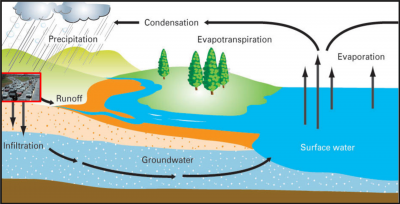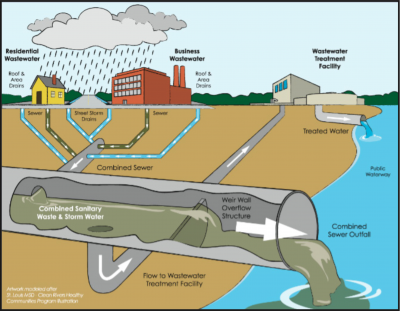What is stormwater?
Stormwater is runoff that is generated by rainfall on impervious surfaces like asphalt, concrete or buildings.
Why is stormwater a problem?
As urban areas expand, these impervious surfaces affect an important part of the water cycle: they send stormwater directly into nearby streams untreated, or in some cases into a combined sewer system, where the extra volume can cause overflows of raw sewage into local waters.
When rain falls on hard surfaces like rooftops, driveways, parking lots and roadways it runs over those areas and in urbanized areas often off into a storm drain. This is great for preventing flooding, but has a hidden impact on water quality. When rain runs off/over hard surfaces it picks up various pollutants along the way (excess fertilizer, oil, brake dust, sand, salt, etc.) and carries them with it into our storm drains which empty directly into your local stream, pond, river or the ocean. Nutrients like phosphorus and nitrogen can cause algae blooms when they enter streams, ponds and salt water estuaries like the Long Island Sound. When algae die, oxygen is depleted in waters, which can impact other aquatic life such as fish. Also, high bacteria levels in stormwater (from pet waste and combined sewer overflows) can result in beach and shellfish bed closures.
So what can be done?
Under the federal Clean Water Act, states establish a program (the MS4 General Permit) that regulates how municipalities (and institutions) manage their stormwater to help reduce the number of pollutants being carried into our water bodies. For more information, check out our MS4 Guide.
There are variety of green stormwater treatment approaches that can reduce the impact of stormwater runoff. Techniques such as pervious pavements, rain gardens, green roofs, and stormwater planters all help to reduce the amount of stormwater that enters local waters. For more information, check out our What is GSI/LID page.


Luck Isn’t Enough
For citation purposes: University of Connecticut’s Center for Land Use Education and Research. (March 14, 2022). Stormwater Basics. https://nemo.uconn.edu/stormwater-basics/